| |
 |
 |
 |
| Comment on this report, or find other reports. |
 |
| Our Mystery Worshippers are volunteers who warm church pews for us around the world. If you'd like to become a Mystery Worshipper, start here. |
 |
| Find out how to reproduce this report in your church magazine or website. |
|
|
| 3107: St Anthony’s Monastery, Florence, Arizona, USA |
 |
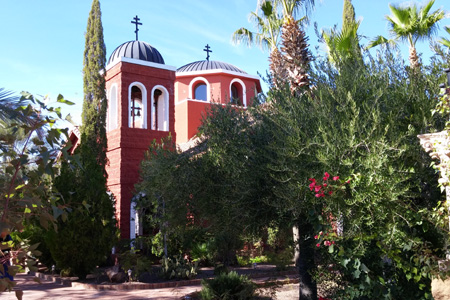 |
 |
Mystery Worshipper: Old Rackensack, accompanied by San Mateo.
The church: St Anthony’s Monastery, Florence, Arizona, USA.
Denomination: Greek Orthodox, Archdiocese of America.
The building: In 1979, an abbot known as Elder Ephraim traveled to America from the Mount Athos community in Greece with a group of monks to establish what would grow into a network of about 20 monasteries in the United States and Canada. One of these is St Anthony’s, which Elder Ephraim founded in 1995. The story goes that as Elder Ephraim drove about Arizona’s Sonoran Desert in a car with several other priests to scout out potential sites, they stopped at a place where they heard monastery bells ringing, although there was nothing but barren desert for miles around. Legend has it that St Anthony himself told Elder Ephraim that water could be found in a well deep beneath the site. Legend also has it that Elder Ephraim miraculously banished all scorpions and rattlesnakes, which thrive in the Sonoran Desert, from the place. The monastery complex consists of a gate house and gift shop, church and several chapels, living quarters, workrooms, dining hall and guest facilities, all nestled amid gardens, vineyards, orchards and olive groves connected by pathways lined with gazebos and fountains.
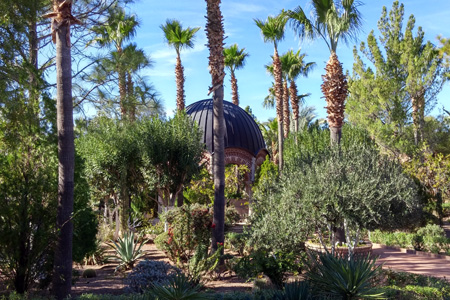
The church: Monks and novices at the monastery follow the coenobitic monastic tradition of living, working and praying in community. Among their work is a project to collect and publish Byzantine liturgical music in both modern and Byzantine notation as well as in Braille, and in Elizabethan English and Modern English as well as Greek. The monks welcome day visitors and pilgrims for overnight stays of up to seven days. St Anthony’s Monastery fell under the glaring spotlight of notoriety in 2013 when a novice who had previously left the monastery returned to commit suicide on the grounds.
The neighborhood: Florence is a small town about 60 miles southeast of Phoenix that was founded in 1866 as a farming community. Much of the historic town site has been preserved as a national historic district. The courthouse at Florence witnessed the trials of several notorious female outlaws of the Old West. Among these were Winnie Ruth Judd, convicted of murdering two of her rivals for a certain gentleman’s affections and shipping their dismembered bodies to Los Angeles by train; Eva Dugan, who was the only woman in Arizona to be executed by hanging; and Pearl Hart, who committed one of the last recorded stagecoach robberies in the United States. Today Florence has the dubious distinction of being the site of no fewer than six federal, state and county prisons, including Arizona’s Death Row. St Anthony’s Monastery is located well outside the town amid wide open spaces.
The cast: No names were given. There were perhaps two dozen or so monks of all ages: young men with long black beards, middle aged men with grey beards, elderly men with white beards all bent over and walking with the aid of canes, and one very elderly monk in a wheelchair. All of the monks wore black inner and outer cassocks (rason and exorasson) and black hoods (epanokamelavkion). A priest and deacon in red vestments – the priest in phelonion (cope) and epitrachelion (stole), the deacon in sticharion (dalmatic) and orarion (deacon's stole) – plus another priest in a white stole, and a monk whose role appeared to be that of lector, were the principal leaders of the service.
The date & time: The Theophany of Jesus Christ, Friday, January 6, 2017, 3.30pm.
What was the name of the service?
Ninth Hour and Vespers.
How full was the building?
The service took place in the main church as opposed to one of the chapels. As non-Orthodox laymen, San Mateo and I were confined to the narthex, but at least we looked the part by dressing all in black. In addition, I wore a silver cross on a chain – a detail that would have significance later on. There were only one or two others in the narthex at first, but as the service progressed the number grew to about a dozen or so. Inside the church proper there were about 20 men and about 30 women. Men sat on the right; women on the left. All ages were represented, ranging from babes in their parents’ arms through teenagers, young adults, middle aged adults, and the elderly. Most of the men dressed casually, although all of the women wore floor-length dresses and either headscarves or veils. There were several groups of nuns in blue or black habits (rasa) and veils (apostolnik).
Did anyone welcome you personally?
When we arrived at the monastery, a woman at the gate house welcomed us and gave us a map of the grounds. She invited us to help ourselves to some cookies that were set out on a plate. She also said that if we wished to stay for the service, we should speak to one of the monks in the gift shop. So we went into the gift shop, where a monk greeted us most cordially and told us that we were very welcome to stay for the service but that as non-Orthodox we should observe it from the narthex. He briefly explained what the service would consist of. Later, inside the church, as we were waiting for the service to start, no one spoke to us. We really didn’t expect it, though.
Was your pew comfortable?
No. The church (as well as all the chapels) were lined with stasidia (misericords) along the walls. They looked wonderful but were extremely uncomfortable to sit on. A small number of wooden folding chairs had also been set out in the narthex and in the church proper, but they, too, were not comfortable.
How would you describe the pre-service
atmosphere?
We toured the monastery grounds, following the map that we had been given. It was great fun stopping in the various chapels and trying to work out which saint each icon represented. My college Greek was of some help, but not much, as the icons were captioned in a florid script and I had trouble making out some of the letters. As service time approached, we entered the main church and settled in the narthex. A steady stream of people entered, crossed themselves, lit candles, and venerated the various icons, all in silence.
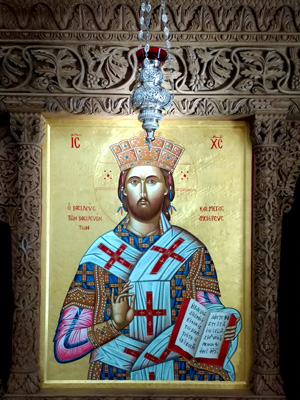
What were the exact opening words of the
service?
I have no idea. Everything was in Greek.
What books did the congregation use during the
service?
None.
What musical instruments were played?
None.
Did anything distract you?
As we toured the grounds, we noticed that air conditioning units had been cleverly concealed at various spots near the buildings. So much for monastic asceticism (although, if truth be told, life in Arizona without air conditioning is a foretaste of hell). As we waited in the church for the service to start, it was something of a distraction – but an interesting one – to observe the ways in which people venerated the icons – kissing them, touching them, prostrating themselves before them, etc. – all the while signing themselves nonstop with the Sign of the Cross as the Orthodox make it.
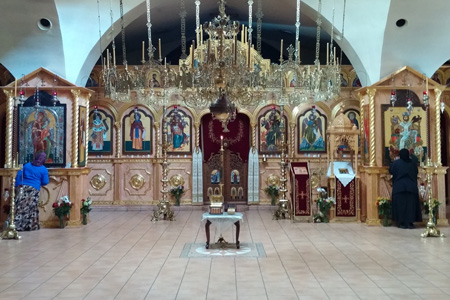
Was the worship stiff-upper-lip, happy clappy, or
what?
Interesting is the only word I can think of to describe it. The church was basically divided into four parts: the sanctuary behind the Royal Doors and iconostasis; the front of the nave, where the monks sat behind wooden screens; the back of the nave, where Orthodox religious and laypersons sat; and the narthex. The service consisted of recited prayers and passages from scripture; chanting (haunting Byzantine melodies chanted above a drone bass); copious incense dispensed by priest and deacon; all-around veneration of every icon in the place by monks and congregation alike; and a final blessing.
Exactly how long was the sermon?
There was no sermon.
Which part of the service was like being in
heaven?
All during the afternoon as we toured the grounds, and later as we watched the service, we felt a hushed sense of awe and holiness. It was clear that we were in a very special place and that something very special was happening, even if we didn’t fully understand it.
And which part was like being in... er... the other place?
And we really didn’t understand it. There were no handouts or booklets provided, and everything was in Greek.
What happened when you hung around after the service looking lost?
After the final blessing, the laypersons in the congregation exited to the narthex and we all stood in silence as the monks and religious in the congregation left the church. A gentleman asked me if I was Orthodox, and when I replied that I wasn’t he said that he knew I was a Christian because I was wearing a cross. I told him I found the service to be a very holy experience, and he seemed pleased by that. He opined that he didn't think that many visitors really knew what was going on. I showed him my Mystery Worship calling card and said that I didn’t know where to leave it without appearing sacrilegious, and he replied that he’d give it to the abbot for me. As we parted, we shook hands and he wished San Mateo and me God's blessing.
How would you describe the after-service
coffee?
The monks and Orthodox religious and laymen retired to the trapeza (dining hall) for dinner. As non-Orthodox, we were told that we could eat what remained after dinner was over, but we had more appetizing plans in mind: dinner at a restaurant on the way home. On our way back to the car we detoured into the gift shop, where I purchased a loaf of bread, a jar of strawberry preserves, and a jar of raw honey. There was quite an assortment of breads, pastries, marmalade, jams and jellies on offer, all made on the monastery grounds by the monks (although San Mateo said that he was certain that the welcoming cookies we were offered when we arrived were from the giant members-only warehouse club, Costco). There was also a wide variety of books, icons and religious trinkets.
How would you feel about making this church your regular (where 10 = ecstatic, 0 = terminal)?
N/A – This was a once-in-a-lifetime experience for us.
Did the service make you feel glad to be a
Christian?
Yes, but in a weird sort of way. We both felt that we had witnessed something very special and very holy, even if we didn’t understand everything that had happened.
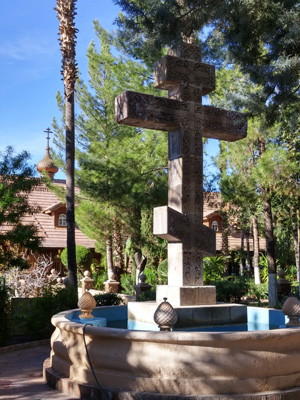
What one thing will you remember about all this in seven days' time?
The extent to which, and different ways in which, everyone venerated the icons. |
|
|
 |
 |
 |
| We rely on voluntary donations to stay online. If you're a regular visitor to Ship of Fools, please consider supporting us. |
 |
 |
 |
| The Mystery Pilgrim |
 |
| One of our most seasoned reporters makes the Camino pilgrimage to Santiago de Compostela in Spain. Read here. |
 |
 |
 |
| London churches |
 |
| Read reports from 70 London churches, visited by a small army of Mystery Worshippers on one single Sunday. Read here. |
| |
|
|
|
|


